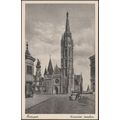Djerba, Tunisia - Turkish Mosque at Houmt-Souk - postcard 1966 pmk
- Condition : Used
- Dispatch : 2 Days
- Brand : None
- ID# : 180691472
- Quantity : 1 item
- Views : 163
- Location : United Kingdom

- Seller : justthebook (+1703)
- Barcode : None
- Start : Sun 12 May 2019 09:49:29 (BST)
- Close : Run Until Sold
- Remain : Run Until Sold
More Listings from This Seller view all
Seller's Description
- Postcard
- Picture / Image: Ile de Djerba - La Mosquee Turque d'Houmt-Souk
- Publisher: H. Ismail, Tunis
- Postally used: yes
- Stamp: Tunisia 50f
- Postmark(s): 1966
- Sent to: Hgh Wycombe, Bucks
- Notes / condition:
Please ask if you need any other information and I will do the best I can to answer.
Image may be low res for illustrative purposes - if you need a higher definition image then please contact me and I may be able to send one. No cards have been trimmed (unless stated).
------------------------------------------------
Postage & Packing:
Postage and packing charge should be showing for your location (contact if not sure).
No additional charges for more than one postcard. You can buy as many postcards from me as you like and you will just pay the fee above once. Please wait for combined invoice. (If buying postcards with other things such as books, please contact or wait for invoice before paying).
Payment Methods:
UK - PayPal, Cheque (from UK bank) or postal order
Outside UK: PayPal ONLY (unless otherwise stated) please. NO non-UK currency checks or money orders (sorry).
NOTE: All postcards are sent in brand new stiffened envelopes which I have bought for the task. These are specially made to protect postcards and you may be able to re-use them. In addition there are other costs to sending so the above charge is not just for the stamp!
I will give a full refund if you are not fully satisfied with the postcard.
----------------------------------------------
Text from the free encyclopedia WIKIPEDIA may appear below to give a little background information (internal links may not work) :
*************
Houmt El Souk (Tunisian Arabic: حومة السوق Ḥūmet es Sūq), meaning literally: "The Market neighborhood", is a commune and the main town of the island of Djerba, Tunisia. A popular tourist destination, it is best known for its traditional souk (market) and the Aghlabid fortress.
It is located at approximately 20 km (12 miles) from Ajim and 22 km (14 miles) from El Kantara by the Roman road. It is also the chief town and a municipality with 75,904 inhabitants. The city itself shelters a population of 44,555 inhabitants as of 2005. The city developed on the old site of a Roman city called Gerba or Girba which had the honor of giving birth to two Roman Emperors, Trebonianus Gallus and his son Volusianus.[1]
The city as it is today developed on the site of an ancient Roman city called Gerba or Girba, which shared its name with the island.[1] Many besides the Romans lived there, including Numidians, Punics, Arabs, Spanish, and Turks; the town was also home to many merchants and pirates for many years. The Battle of Djerba took place in the northern part of the city. Close to the fort is a large village which served as a market; cattle and woolen cloth were traded there, as were dried grapes. Under the French protectorate (1881–1956) the island was divided into twelve sheikhates.[2] French soldiers entered the town on July 28, 1881, and it remained a garrison until 1890, when its administration passed to civil French authority. In 1956, upon Tunisian independence, it became the capital of Djerba.
Houmt Souk is located on a plain on the northern coast of Djerba. There is an artesian well, called Bir Erroumi, 767 meters deep, which was dug under French rule. The city is divided into several districts; the three major ones are Taourit, Boumellel, and Hara El K' will bira, which in turn includes neighborhoods like Fatou, Thouirane, Houmet Eljouamaa and Binibandou. These three districts are located in the northern part of town. The climate of the city is moderate, with a semi-arid tendency, and receives a breezefrom the sea in summer.
Due to the density of the city center, its architectural character sometimes differs from that of the rest of the island. The typical menzel may especially be noticeably different; in addition, a new architectural style in which the courtyard is missing may be seen in some more modern houses. Dominant colors remain sharp white for masonry and sky blue for doors and windows. The city has several small streets connected by arcades, and there are a number of covered souks like that of Errbaâ, or the more recent Central Market.
Fondouks in town, dating back several centuries, often follow the same building style; a generally square courtyard with a group of stores may be found at ground level, along with a door with a heavy lock. This is sometimes joined by an attic window in the area were goods were stored. Animals, carts and equipment were sheltered in the yard. The first floor, reached by a single staircase, has a gallery supported by columns and arches; this is often the point of access for a number of rooms or storerooms. Many such buildings may still be seen in the downtown area, where they have been turned into hotels and youth hostels; some have even become tourist malls.[3] The coastal area, formerly deserted, is becoming increasingly urbanized.
As befits a Muslim country, mosques are numerous in the city, and their architecture varies greatly. Several are built in a style native to the island, among which is the Jemaâ El Ghorba (literally mosque from abroad) of the Maliki rite. The Jemaâ Ettrouk (mosque of the Turks), of the Hanafi rite, dates back to the 18th century and is equipped with a minaret typical of Ottoman style. There is also the Sidi Brahim El Jemni, built in 1674, with a roof with multiple vaults and a zaouia containing the tomb of a saint. These three mosques are classified as historic buildings. Sidi Bouakkazine, located near the public library, is built of centuries-old green tiles, and also houses a zaouia with a saint's tomb. Called Lella Gmira, this is visited most often by women suffering from infertility; they wash and light a candle there in the hope of gaining a blessing, and perhaps giving birth.
A little further out of town, on the road to Ajim, may be seen the Sidi Bouzid of the Ibadi rite. Sidi Salem and Sidi Youssef are located on the new speedway to the airport, and the Jemaâ Ejdid may be seen on the road to Mellita. Jamaâ Echeikh, Jemaâ El Bassi and Jemaâ El Guellal are in the same neighborhood in the south-east of Houmt Souk.
Legends surround a number of the town's mosques. Sidi Zitouni, located not far from Jamaâ Ettrouk and which houses another saint's tomb as well as the Museum of Arts and Popular Traditions, is one of them. According to lore, the mosque is inhabited by djinns that appear only in the early evening. Consequently, Djerbians will leave the mosque only at sunset. Another story concerns Jemaâ El Guellal: supposedly a potter in the eighteenth century put his pots, which had taken months to craft, on a cart to be taken to market. While on the road the cart overturned, dropping its contents to the ground. The potter nevertheless decided to save what he could, discovering with great astonishment that all his wares were intact. Upon selling them, and seeing divine intervention in the episode, he chose to build a mosque at the site of the accident.
Jamâa Tajdid, whose construction was begun in the nineteenth century and entrusted to Abou Messeouar, is on the road to Midoun. Messeouar completed the work with the help of his son.[4]
There are several small synagogues in Hara El K'bira and Hara Sghira districts, the latter being a community of around 100 Jews. In addition, a Catholic church may be found in the center of town, and a Greek Orthodox structure is located near the port, by the hotel Lottos, one of the island's first hotels.
Listing Information
| Listing Type | Gallery Listing |
| Listing ID# | 180691472 |
| Start Time | Sun 12 May 2019 09:49:29 (BST) |
| Close Time | Run Until Sold |
| Starting Bid | Fixed Price (no bidding) |
| Item Condition | Used |
| Bids | 0 |
| Views | 163 |
| Dispatch Time | 2 Days |
| Quantity | 1 |
| Location | United Kingdom |
| Auto Extend | No |




 for 1 item(s)
for 1 item(s)

















